William Henry Playfair
| William Henry Playfair FRSE | |||||||||
|---|---|---|---|---|---|---|---|---|---|
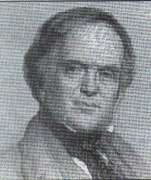 | |||||||||
| Born |
15 May 1790 London, England | ||||||||
| Died |
19 March 1857 (aged 66) Edinburgh, Scotland | ||||||||
| Burial place | Dean Cemetery | ||||||||
| Nationality | Scottish | ||||||||
| Education | University of Edinburgh | ||||||||
| Style | Neoclassical | ||||||||
| Home town | Edinburgh | ||||||||
| Parent(s) |
| ||||||||
| Relatives | John Playfair (uncle), William Playfair (uncle) | ||||||||
| |||||||||
| Signature | |||||||||
|
| |||||||||
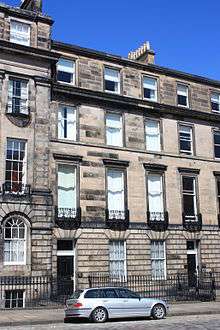


William Henry Playfair FRSE (15 July 1790 – 19 March 1857) was one of the greatest Scottish architects of the 19th century,[1] designer of the Eastern, or Third, New Town and many of Edinburgh's neoclassical landmarks.
Life
Playfair was born on 15 July 1790 in Russell Square, London to Jessie Graham and James Playfair.[2][3] His father was also an architect, and his uncles were the mathematician John Playfair and William Playfair, an economist and pioneer of statistical graphics. After his father's death he was sent to Edinburgh be educated by his uncle John Playfair. He went on to study at the University of Edinburgh, graduating in 1809.[2] He was first articled to the architect William Stark but when Stark died in 1813, he went to London.
In the 1830s Playfair is listed as living at 17 Great Stuart Street on the prestigious Moray Estate in Edinburgh's west end.[4] Ironically, this is not a building of his own design, but is by his rival James Gillespie Graham.[5]
Playfair joined the Free Church following the Disruption of 1843,[6] losing his right to burial in the parish churchyard.
Playfair took David Cousin under his wing and was responsible for the latter part of his training.
Playfair died in Edinburgh on 19 March 1857, and is buried in the "Lord's Row" on the western wall of Edinburgh's Dean Cemetery, where he designed a number of monuments for others, including Lord Jeffrey.
Major works
Two of his finest works are the neoclassical buildings of the National Gallery of Scotland and the Royal Scottish Academy which are situated in the centre of Edinburgh. The Playfair Project, completed in 2004, joined the two historic buildings with an underground link.
Timeline of major projects
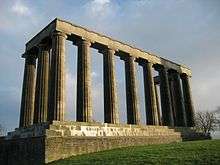
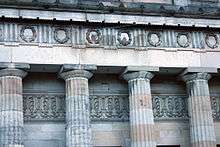
- 1817 Appointed architect to complete design work on the Old College, University of Edinburgh, on the basis of his proposals to complete the plans originated by Robert Adam. The building was completed around 1831.
- 1818 Commissioned to design Dollar Academy: the original building which he created is now known as the Playfair Building[7]
- 1818 City Observatory, Calton Hill
- 1820 East New Town (Calton Hill), Edinburgh (including Regent, Carlton and Royal Terraces), built between 1821 and 1860
- 1821–24 Royal Terrace, East New Town, Edinburgh only completed in 1860
- 1822 Commissioned by the Institution for the Encouragement of Fine Arts in Scotland. The building was opened in 1826 and is now the Royal Scottish Academy Building, Edinburgh
- 1823 Royal Circus, New Town, Edinburgh
- 1824 in collaboration with Charles Robert Cockerell, designed an exact replica of the Parthenon which was to be built on top of Calton Hill as the National Monument, Edinburgh. However, due to lack of investment it was never finished and became known as Edinburgh's Disgrace.
- 1825 Regent and Carlton Terraces, East New Town, Edinburgh, completed in the 1830s
- 1826 John Playfair Monument, (he was William Henry's uncle), Calton Hill, Edinburgh
- 1827 – 1828 St Stephen's Church, St Stephen's Place, Silvermills, Edinburgh
- 1829 Drumbanagher House (demolished), London Road Gardens, Edinburgh
- 1830 – 1832 For the Royal College of Surgeons of Edinburgh, Surgeons' Hall, Nicolson Street, Edinburgh
- 1831 Dugald Stewart Monument, Calton Hill, Edinburgh
- circa 1837 renovations to Floors Castle, outskirts of Kelso, Scottish Borders
- 1846 – 1850 New College, Edinburgh
- 30 August 1850 Prince Albert laid the foundation stone of the National Gallery of Scotland. adjacent to The Royal Scottish Academy.
- 1851 Donaldson's College, Edinburgh
- 1859 National Gallery of Scotland opened to the public two years after Playfair's death.
Gallery of architectural work
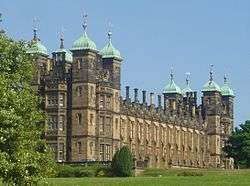 Donaldson's College, Edinburgh 1851
Donaldson's College, Edinburgh 1851 Old College, Edinburgh University
Old College, Edinburgh University Old College, Edinburgh University
Old College, Edinburgh University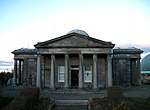 City Observatory, Edinburgh
City Observatory, Edinburgh Three Edinburgh buildings by Playfair
Three Edinburgh buildings by Playfair Royal Scottish Academy
Royal Scottish Academy Royal Scottish Academy frontage
Royal Scottish Academy frontage Sphinxes on the Royal Scottish Academy
Sphinxes on the Royal Scottish Academy- Regent Terrace, Edinburgh
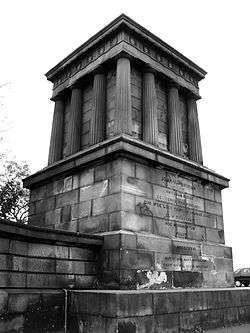 John Playfair Monument, Calton Hill, Edinburgh
John Playfair Monument, Calton Hill, Edinburgh St. Stephen's Church Edinburgh
St. Stephen's Church Edinburgh Surgeons' Hall, Edinburgh
Surgeons' Hall, Edinburgh Dugald Stewart Monument, Calton Hill, Edinburgh
Dugald Stewart Monument, Calton Hill, Edinburgh Floors Castle, near Kelso
Floors Castle, near Kelso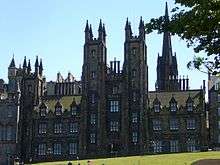 New College, Edinburgh
New College, Edinburgh National Gallery of Scotland, Edinburgh
National Gallery of Scotland, Edinburgh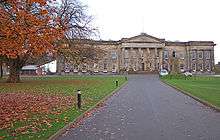 Dollar Academy, Clackmannanshire
Dollar Academy, Clackmannanshire
References
- ↑ Russell, Colin (2014). Who Made the Scottish Enlightenment?. Xlibris Corporation. p. 385. ISBN 9781499091045.
- 1 2 McKean, Charles. Playfair, William Henry (1790–1857), architect. Oxford Dictionary of National Biography. Oxford University Press. doi:10.1093/ref:odnb/22371.
- ↑ Waterston, Charles D; Macmillan Shearer, A (July 2006). Former Fellows of the Royal Society of Edinburgh, Vol. II. Edinburgh: The Royal Society of Edinburgh. ISBN 978-0-902198-84-5.
- ↑ "Edinburgh - Post Office annual directory -1832–1833". National Library of Scotland.
- ↑ CEC: listed buildings in Edinburgh
- ↑ Dictionary of Scottish Architects:David Cousin
- ↑ "Our History – Independent Day and Boarding School – Dollar Academy". dollaracademy.org.uk. Retrieved 8 September 2016.
Sources
Further reading
- Gow, Ian (1984): William Henry Playfair in Scottish Pioneers of the Greek Revival, The Scottish Georgian Society, Edinburgh, pp 43–55
External links
| Wikimedia Commons has media related to William Henry Playfair. |
![]()